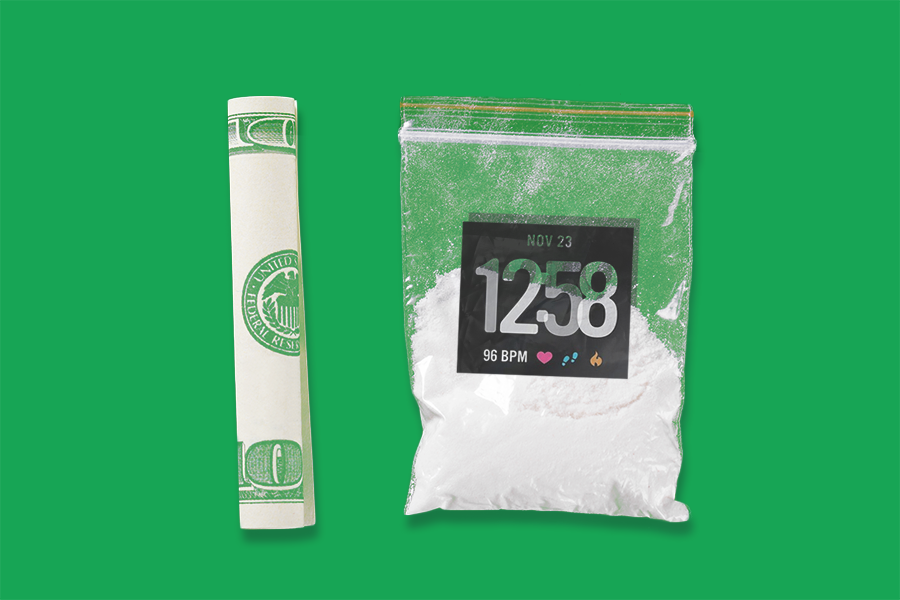Human beings are innovators. You can hardly create a product before somebody’s come up with a use for it you never considered. (Even Viagra was originally developed as a pill to lower blood pressure — erections were merely a side effect.)
So I don’t think we can be too surprised that people are using fitness trackers to monitor their vitals while taking recreational drugs. As CNBC first reported, some drug users find wearable devices like the Apple Watch and the Fitbit helpful in managing their intake of stimulants, which tend to get your heart rate up. They reason that by keeping their heart below a certain threshold of beats per minute (bpm) while high, they can lessen the always-present risk of an acute cardiac event. And so, ever since the consumer technology to keep tabs on your pulse 24/7 first became available, they’ve been sharing health data from their binges in online drug forums like the r/cocaine subreddit, for example:
Clearly, you can see one of coke’s (multifarious) effects on your body in real time with these gadgets strapped to your wrist. But what is the practical value of that information, if any?
I got in touch with “X,” a 19-year-old male redditor who frequents r/cocaine and tracks his bpm while indulging in his favorite intoxicants, which include alcohol and the anti-anxiety tranquilizer Xanax, as well as coke. He says that while his Apple Watch is mostly “shitty,” its heart rate monitoring feature is “the best and most useful thing about it.” His interest in the data depends on what he’s taking, of course: “For Xanax I make sure [my heart rate] doesn’t fall under a certain number,” he explains, while with coke he wants to avoid “going over a certain number.”
And the numbers are certain. “My resting heart rate is usually 80. If I’m on Xanax I usually don’t want it dropping under 50,” X says. “And on coke, anything above 140 is when I stop. If it’s falling too low while on Xanax, then it’s okay, because I can just go take a nap and stop drinking if I was. On coke, if it starts getting too high, I’ll take a Xanax to calm my heart rate down.”
I ask X if this method of dosing feels more reliable than what most everyone else has had to do throughout the history of inebriation — go with their gut instinct. “Yes, it is,” he says, though he’ll rely on his own best judgment as well, particularly in a party setting. Speaking of which: The fitness tracker binge, like cocaine itself, is a rather social phenomenon. “The first time I did it,” X explains, was “with people who have done it for a long time, so then after I just learned from them.” Later, he got his friends with wearables to monitor their heart rates as well, and they share their bpm often, whether hanging out together or not. “Some of us have higher tolerances, so we use it to keep [tabs on] each other,” he says.
Sounds pretty responsible, doesn’t it? Dr. Robert A. Kloner, the Chief Science Officer and Director of Cardiovascular Research at Huntington Medical Research Institutes, disagrees completely. “Not a good idea,” he writes in an email when I ask him about the trend. “It will lead people to have a false sense of security.”
Not only is Kloner an expert on the heart and blood vessels, he also co-authored work on the cardiovascular effects of cocaine, which can be extreme. There’s more to worry about than how fast your heart is beating, he points out: “Cocaine can cause coronary artery vasospasm; increase the oxygen need of the heart by increasing contractility; it can cause the blood pressure to go up; it can cause arrhythmias; it can cause heart muscle cells to go into contracture; it has been associated with ruptured aneurysm, seizures, strokes and heart attacks,” he explains, adding that the drug can also “increase the aggregation of platelets.”
Unfortunately, your Apple Watch isn’t going to be much help in predicting any of those dire outcomes. “Using heart rate monitoring devices only gives one physiologic parameter for a drug that has complicated effects on the cardiovascular system,” Kloner tells me, concluding that “the best way to avoid cocaine cardiotoxicity is to avoid cocaine to begin with.”
Naturally.
But it seems that X has figured out a system he likes, and he knows what to look for — at least as far as a decent high is concerned. If the coke is of a better quality, “rocky and scaley,” then he’ll notice a jump in bpm “almost instantly” after taking some, with a pulse fall-off 45 to 60 minutes later. “If it’s stepped on,” he says — which is to say cut with other ingredients — he gets the same instant bump, but a much quicker fall-off in heart rate, somewhere in the 10 to 15 minute range. And while he never wants to soar above 140 bpm, “around 120 is perfect for me,” he says. Apart from this niche functionality, he only uses the heart rate monitor “occasionally” while sleeping.
X isn’t too bothered about Apple having this data, either. “Well, yeah, sometimes it does feel weird,” he admits. “But at the same time, I do work out, so my heart rate is constantly at that point.” Besides, as the excitement of this year’s World Cup and other intense situations have proved, the causes of bpm surges during physical “inactivity” are varied and strange.
I got a fitbit for my brithday a few days ago. Its currently telling me my heart is almost doubled my average resting bpm. If I die, at least let me see England go through first
— Callum-Kai Larsen (@CKLDefianT) July 3, 2018
My Fitbit just warned me my heart rate had been at high exercise levels for 45 minutes and it was time to start my cooldown routine for my workout.
….I’ve been on a call with my boss’ boss sitting in my office chair.
— Christopher Law U+2714 (@Christopherglaw) May 16, 2018
My heart rate went over 120 bpm while inactive at 11:04pm (thanks Apple Watch) because I found out Tony Parker was LEAVING THE SPURS???? pic.twitter.com/oryla21InZ
— Racquelita (@racquel_rod) July 7, 2018
Even as drug users like X seek the equilibrium to their inebriation with the aid of heart rate monitoring, others are taking cues from the tech to pop their legally prescribed drugs.
https://twitter.com/AnnitaDarling/status/1016707006688735232
After all, the point of a fitness tracker is to help you manage your health. Fitbits and Apple Watches may not make drug use safer, but these devices will improve, offering broader, deeper and more accurate analysis of what’s going on with our bodies, and owners will interpret that new information however they like.
For now, however, most would rather stay analog:

